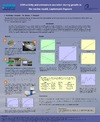Identificador persistente para citar o vincular este elemento:
https://accedacris.ulpgc.es/jspui/handle/10553/7225
| Campo DC | Valor | idioma |
|---|---|---|
| dc.contributor.author | Fernández-Urruzola, Igor | en_US |
| dc.contributor.author | Packard, Theodore T. | en_US |
| dc.contributor.author | Gómez, May | en_US |
| dc.date.accessioned | 2012-04-10T08:58:56Z | |
| dc.date.accessioned | 2018-06-18T06:51:37Z | - |
| dc.date.available | 2012-04-10T08:58:56Z | |
| dc.date.available | 2018-06-18T06:51:37Z | - |
| dc.date.issued | 2010 | en_US |
| dc.identifier.uri | https://accedacris.ulpgc.es/handle/10553/7225 | - |
| dc.description.abstract | Ammonium (NH4+) and nitrate (NO3-) are the main constituents of the inorganic nitrogen pool that supports primary production in marine systems. NH4+ release via glutamate deamination in heterotrophic organisms represents the largest recycled nitrogen source in the euphotic zone, supporting around the 80 % of the primary producers requirements (Harrison, 1992). Glutamate dehydrogenase (GDH) is the enzyme that catalyzes this process. This fact has lead to the use of GDH activity as an index, a proxy, for physiological NH4+ formation. The result is a measure of potential excretion that avoids incubation artefacts due to manipulation of the organisms. The relationship between GDH activity and NH4+ excretion in cultures of the marine mysid Leptomysis lingvura is analyzed here. With interspecific and environmental interferences minimized, the study shows that the relationship between GDH activity and NH4+ excretion in L. lingvura is similar to equivalent results measured on mixed assemblages of zooplankton. | en_US |
| dc.language | eng | en_US |
| dc.source | SIEBM. XVI Simposio Ibérico de Estudios de Biología Marina. Alicante (España), 6-10 Septiembre 2010. | en_US |
| dc.subject | 251001 Oceanografía biológica | en_US |
| dc.subject.other | Glutamate dehydrogenase | en_US |
| dc.subject.other | Ammonium excretion | en_US |
| dc.subject.other | Leptomysis lingvura | en_US |
| dc.subject.other | Body Size | en_US |
| dc.title | GDH activity and ammonium excretion during growth in the marine mysid, "Leptomysis lingvura" | en_US |
| dc.type | info:eu-repo/semantics/conferenceobject | en_US |
| dc.type | Conference poster | en_US |
| dc.identifier.absysnet | 659339 | - |
| dc.investigacion | Ciencias | en_US |
| dc.rights.accessrights | info:eu-repo/semantics/openAccess | es |
| dc.type2 | Póster de congresos | en_US |
| dc.utils.revision | Sí | en_US |
| dc.identifier.ulpgc | Sí | en_US |
| item.grantfulltext | open | - |
| item.fulltext | Con texto completo | - |
| crisitem.author.dept | GIR ECOAQUA: Ecofisiología de Organismos Marinos | - |
| crisitem.author.dept | IU de Investigación en Acuicultura Sostenible y Ec | - |
| crisitem.author.dept | GIR ECOAQUA: Ecofisiología de Organismos Marinos | - |
| crisitem.author.dept | IU de Investigación en Acuicultura Sostenible y Ec | - |
| crisitem.author.dept | Departamento de Biología | - |
| crisitem.author.orcid | 0000-0001-7287-3503 | - |
| crisitem.author.orcid | 0000-0002-5880-1199 | - |
| crisitem.author.orcid | 0000-0002-7396-6493 | - |
| crisitem.author.parentorg | IU de Investigación en Acuicultura Sostenible y Ec | - |
| crisitem.author.parentorg | IU de Investigación en Acuicultura Sostenible y Ec | - |
| crisitem.author.fullName | Fernández Urruzola, Igor | - |
| crisitem.author.fullName | Packard, Theodore Train | - |
| crisitem.author.fullName | Gómez Cabrera, María Milagrosa | - |
| Colección: | Póster de congreso | |
Visitas
48
actualizado el 27-ene-2024
Descargas
22
actualizado el 27-ene-2024
Google ScholarTM
Verifica
Comparte
Exporta metadatos
Este elemento está sujeto a una licencia Licencia Creative Commons

